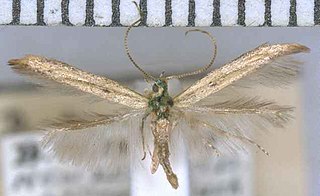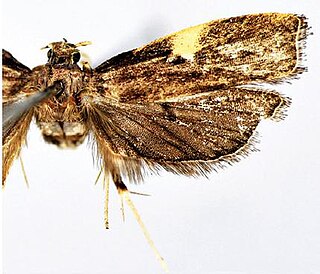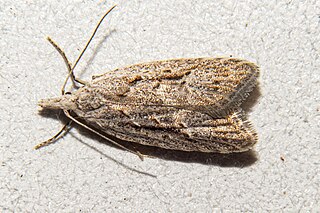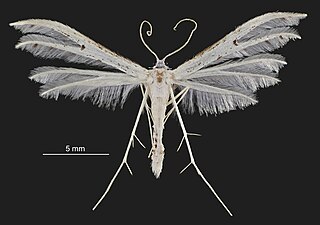
Homaloxestis is a genus of moths in the family Lecithoceridae. The genus was erected by Edward Meyrick in 1910.

Lecithocera is a genus of moths in the lecithocerid subfamily Lecithocerinae. The genus was erected by Gottlieb August Wilhelm Herrich-Schäffer in 1853.

Thubana is a genus of moths in the family Lecithoceridae and subfamily Torodorinae. The genus was erected by Francis Walker in 1864.
Torodora is a genus of moths in the family Lecithoceridae. The genus was erected by Edward Meyrick in 1894.

Isodemis is a genus of moths belonging to the subfamily Tortricinae of the family Tortricidae.

Batrachedra arenosella, the armoured scale eating caterpillar or the coconut moth, is a species of moth of the family Batrachedridae. It was first described by Francis Walker using specimens collected in Auckland, New Zealand. It has been hypothesised that the New Zealand moth may contain two distinct species. As well as the moth species in New Zealand, this name has been applied, perhaps incorrectly, to moths found in India, Indonesia, the Malay Peninsula, and Réunion, as well as in Australia, from the Northern Territory and northern Queensland to New South Wales and South Australia.

Thubana felinaurita is a species of moth of the family Lecithoceridae. It is found in Guangxi in China.

Thubana dialeukos is a species of moth of the family Lecithoceridae. It is found in Yunnan in China and in Thailand.

Thubana leucosphena is a species of moth of the family Lecithoceridae. It is found in China and Vietnam.

Sabatinca chrysargyra is a species of moth belonging to the family Micropterigidae. It was described by Edward Meyrick in 1886 and is endemic to New Zealand. It can be found from Franz Josef Glacier / Kā Roimata o Hine Hukatere south but only on the western side of the South Island. Adults are on the wing from the beginning of October until the middle of January. Larvae likely feed on foliose liverworts and have been found on species in the genus Plagiochila. The adult moths live in a range of habitats preferring sunny open spaces in forests or snow-tussock grasslands that can range in altitude from near sea level up to 1,230 m. This species is very similar in appearance to Sabatinca aemula and dissection of genitalia is required to distinguish between the two species.

Heterocrossa cryodana is a species of moth in the family Carposinidae. It is endemic to New Zealand and is found in the southern parts of the South Island as well as at Codfish Island / Whenua Hou. This moth is associated with plants in the Leptospermum genus. Adults are on the wing from September until January.

Heterocrossa epomiana is a species moth in the family Carposinidae. It is endemic to New Zealand and has been observed in Westland. Adults are on the wing in January. This species is visually very similar to H. gonosemana and to H. philpotti.

Pterophorus monospilalis, the white plume moth, is a moth of the family Pterophoridae. It is endemic to New Zealand and occurs throughout the country. It inhabits native forest, parks and domestic gardens. Larvae are active during the day, are slow moving, and feed exposed. They feed on Araliaceae species as well as on Hedera helix, Meryta sinclairii, and Schefflera digitata. There are several broods in a year. Adult moths are on the wing from November until May and are attracted to light.
Homaloxestis cholopis is a moth in the family Lecithoceridae. It is found in Taiwan, China, Myanmar, Nepal, India, Java and south-western Africa.
Thubana erycinae is a moth in the family Lecithoceridae. It was described by Kyu-Tek Park and John B. Heppner in 2009. It is found on Sumatra.
Torodora chiangdoica is a moth in the family Lecithoceridae. It was described by Kyu-Tek Park in 2002. It is found in Thailand.
Torodora crassidigitata is a moth in the family Lecithoceridae. It was described by Hou-Hun Li in 2010. It is found in Yunnan, China.
Torodora flavescens is a moth in the family Lecithoceridae. It was described by László Anthony Gozmány in 1978. It is found in southern China and Thailand.
Torodora parotidosa is a moth in the family Lecithoceridae. It was described by Chun-Sheng Wu in 1994. It is found in China (Guangdong) and Thailand.
Torodora pegasana is a moth in the family Lecithoceridae. It was described by Chun-Sheng Wu and You-Qiao Liu in 1994. It is found in China (Hainan), Vietnam and Thailand.













